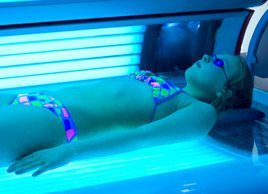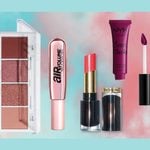Let’s outlaw tanning beds for teens
Why our governments should be doing more to shield young people from harmful radiation

Source: Best Health Magazine, May 2009
The younger someone gets a first suntan or burn, the greater the risk of developing skin cancer later in life. So we slather sunscreen on our toddlers to limit their exposure to the sun’s ultraviolet radiation (UVR). Yet, too often, our teens are soaking up the hazardous UVR from tanning beds.
UVR’whether from the sun or tanning lamps’damages the skin’s DNA, which can cause genetic mutations that might lead to skin cancer. The deadliest form, melanoma, is the second most common cancer among Canadians age 15 to 34. And the numbers are going up. ‘You can’t blame only tanning beds for rising rates of skin cancer,’ says Loraine Marrett, an epidemiologist and senior scientist at Cancer Care Ontario. ‘But they add to the risk.’ So much of a person’s skin is exposed on a tanning bed’and machines emit five times the UVR of the midday sun.
A survey by the Canadian Cancer Society (CCS) found that an alarming 27 percent of females and eight percent of males age 16 to 24 used tanning equipment in 2006. Using tanning beds before age 35 can increase a person’s risk of melanoma by an incredible 75 percent, according to a review of studies on UVR exposure from artificial sources published in the International Journal of Cancer in 2007. If we apply this percentage to numbers from a 2007 CCS survey that showed 50,000 Ontario youth under 18 had used tanning equipment, it means that up to 37,500 teens are in danger of developing skin cancer later in life. And that’s just one province.
‘The issue here is safety,’ says Dr. David McLean, head of prevention programs at the BC Cancer Agency, a professor of dermatology at the University of British Columbia and a strong advocate for a ban on tanning beds for teens. ‘At age 18, or 19 in some jurisdictions, one is legally assumed to make rational decisions as an adult. Until then, society protects young people from making the wrong choices: We don’t let them smoke cigarettes or drink alcohol legally. Why do we permit them to use tanning salons, a known cancer risk?‘
Despite the dangers, the number of tanning salons has risen by five percent each year for the past five years, according to Steve Gilroy, executive director of the Kelowna, B.C.-based Joint Canadian Tanning Association (JCTA). It represents about 1,600 of the country’s estimated 5,000 tanning facilities. Gilroy says most teens come in’often accompanied by their parents’to get a base tan before a sunny holiday. The busiest season for salons runs from January to June (when many teens tan before their prom). Gilroy adds that some JCTA members have parental consent policies in place for youth under age 16 or 18.
Fabutan, a Calgary-based operator of 150 tanning bed franchises across Canada, put an educational brochure and consent program in place about two and a half years ago. ‘Anecdotally, we haven’t seen a drop ‘in teen tanning, so I would say it’s probably a comfort for parents to be involved in the decision-making process,’ says president Doug McNabb.
Health Canada has voluntary ‘Guidelines for Tanning Salon Owners, Operators and Users,’ which’among other recommendations’suggest that operators not allow youth under the age of 16 to tan. But a 2007 survey by the Ontario division of the CCS found that 60 percent of tanning facilities did not ask the age of young tanners.
Time for legislation
McLean argues that parental consent forms and voluntary guidelines are not working, so we need legislated rules. Indeed, in 2003 the World Health Organization called for countries to impose a ban on youth under 18 using artificial tanning beds. Scotland, France and a handful of Australian and American states have put bans in place.
Yet the only Canadian jurisdiction with similar restrictions is New Brunswick; in 1992, it banned those under 18 from using tanning beds. However, it plans to repeal the legislation in an attempt to send a message that tanning beds are not safe for anyone.
The call for a ban by the CCS’s Ontario division inspired MPP Khalil Ramal to put forward a private member’s bill banning youth under 18 from tanning salons. Bill 83 made it to second reading last year, and has been referred to the Standing Committee ‘on Social Policy (it’s not known when, or if, it will decide to proceed). For its part, the Ontario Ministry of Health avoids questions on tanning salons, saying it’s focusing its efforts on sun safety awareness. In British Columbia, the Ministry of Healthy Living and Sport is reviewing a ban on artificial tanning for youth under 18, proposed by the provincial division of the CCS. None of the other provinces or territories is currently considering such a ban.
No safe tans
One of the arguments made by the tanning bed industry is that artificial tanning helps prevent ‘overexposure’ to UVR because it allows people to tan gradually. ‘Your body ‘is naturally designed to create a tan,’ says Gilroy of the JCTA.
But health experts argue there’s no such thing as a healthy or base tan. ‘A tan is a response of your skin being injured by UVR regardless of whether you burn,’ says Dr. Cheryl Rosen, head of dermatology at Toronto Western Hospital and the University Health Network. She also points out that UVR exposure poses increased risk of cataracts (a clouding of the eyes’ lenses), premature skin aging and potential weakening of the immune system in the skin.
Counters Fabutan’s McNabb: ‘We just don’t buy into the argument that any tan is a form of skin damage.’ Yet he acknowledges that a tan as a result of UVR exposure does damage the skin’s collagen, which accelerates signs of aging.
Given the clear-cut evidence of risk and the progressive stance against artificial tanning taken by other countries, why aren’t all Canadian provinces working on bans for those under 18? And without such a ban, what are concerned parents to do?
One thing they can do is set a good ex’ample by avoiding tanning salons and discouraging teens from valuing a sun-bronzed look. If that doesn’t work, McLean recommends self-tanning lotions or sprays.
What you can do
‘ Talk to your teen about the cancer risk and aging concerns. If youth understood the dramatic aging effects of UVR exposure, they would be horrified, says McLean. ‘Among dermatologists, we call it the ‘Miami Beach Syndrome,’ where 30-year-olds have the skin of 80-year-olds.’
‘ Make sure tanning promotions aren’t making it into your kids’ schools. Talk to the principal, or the local school board, to check that a policy is currently in place.
‘ Keep a supply of high-SPF sunscreen on hand‘it can be expensive and a low priority for teens. Buy ‘broad spectrum,’ which means it protects against the sun’s UVA and UVB rays.
‘ Send a letter to your MP supporting a ban. Click to use our letter as a template.




